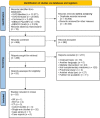Systematic review about complementary medical hyperthermia in oncology
- PMID: 35767077
- PMCID: PMC9244386
- DOI: 10.1007/s10238-022-00846-9
Systematic review about complementary medical hyperthermia in oncology
Abstract
Hyperthermia is a generic term for different techniques using heat in cancer therapies. Temperatures of about 42° Celsius in combination with chemo- or radiotherapy may improve the effectiveness of those treatments. Clinical benefit is shown in "standard hyperthermia" with tumour temperatures assessed during treatment. This systematic review thoroughly assesses the state of evidence concerning the benefits and side effects of electro hyperthermia or whole-body hyperthermia ("alternative hyperthermia") in oncology. From 26 April 2021 to 09 May 2021, a systematic search was conducted searching five electronic databases (Embase, Cochrane, PsycINFO, CINAHL and Medline) to find studies concerning the use, effectiveness and potential harm of alternative medical hyperthermia therapy on cancer patients. From all 47,388 search results, 53 publications concerning 53 studies with 2006 patients were included in this systematic review. The patients were diagnosed with different types of cancer. The hyperthermic methods included whole-body hyperthermia (WBH) with different methods and electro hyperthermia (EH). The majority of the included studies were single-arm studies, counting in total 32 studies. Six studies were randomized controlled trials (RCT). In addition, one systematic review (SR) was found. The most critical endpoints were tumour response, survival data, pain relief, myelosuppression and toxicities. Outcome was heterogeneous, and considering the methodological limitations, clinical evidence for the benefit of alternative hyperthermia in cancer patients is lacking. Neither for whole-body hyperthermia nor for electro hyperthermia there is any evidence with respect to improvement of survival or quality of life in cancer patients.
Keywords: Electro hyperthermia; Extracorporeal circulation; Neoplasm; Whole-body hyperthermia.
© 2022. The Author(s).
Conflict of interest statement
The authors declare no conflicts of interest.
Figures
Comment in
-
Commentary on "Systematic review about complementary medical hyperthermia in oncology" by Liebl et al.Clin Exp Med. 2022 Nov;22(4):667-672. doi: 10.1007/s10238-022-00902-4. Epub 2022 Oct 14. Clin Exp Med. 2022. PMID: 36239869 Free PMC article. No abstract available.
References
-
- Weg-Remers S. Hyperthermie: wärme gegen krebs. In: Krebsinformationsdienst des Deutschen Krebsforschungszentrums. 2018. https://www.krebsinformationsdienst.de/behandlung/hyperthermie.php#inhalt17. Accessed from 2 Jul 2019.
-
- Hossfeld DK, Hegewisch-Becker S, Jäger E, et al. Ganzkörper-hyperthermie in kombination mit chemotherapie. Dtsch Arztebl Int. 2000;97:2941–2946.
Publication types
MeSH terms
Grants and funding
LinkOut - more resources
Full Text Sources
Medical
Research Materials
Miscellaneous




